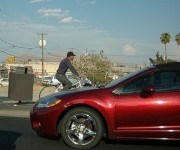Bike racks outside a coffee shop in Las Vegas help attract more cyclists.Photo: Elly Blue
Elly Blue is on a monthlong Dinner & Bikes tour around the western U.S., along with Portland bike filmmaker Joe Biel and traveling vegan chef Joshua Ploeg. This is one of her thrice-weekly dispatches from the road about bicycle culture and economy. Read them all here.
Las Vegas, Nev.: Later this week, the mammoth bicycle trade show Interbike will descend on a convention center here on the Las Vegas Strip. But less-than-badass cyclists are advised to stay inside: “Every single person in Vegas who rides a bike has been hit by a car,” says one of the handful of men who have gathered in a local coffee shop, all in various stages of sweatiness and bikester apparel.
He looks around for validation at the others who are here for our latest stop on the Dinner & Bikes Tour, a traveling road show/vegan chow fest aimed at spreading the word about the bike economy. The others nod and raise their hands in acknowledgment. One guy looks up briefly from his blackberry. “I haven’t,” he says. “But I know how to ride.”
Old town Las Vegas was built before cars took over the streets and the casinos — and roads around them — scaled up in an arms race of size and spectacle. The resulting sprawling mess is cobbled together out of massive buildings on giant blocks with giant roads criss-crossing them. Empty lots full of gravel abound.
Despite the vast amounts of space, anyone not in a car competes for too-narrow strips of sidewalks, on which most bicyclists ride and into which bus shelters are somehow shoehorned, along with boxes of pamphlets for the city’s ubiquitous “escort services.” It’s not uncommon to see someone riding a motorized wheelchair in the traffic lane, hugging the curb as cars pass fast and close.
The group tonight is small but enthusiastic, all young people, including Heather, the woman behind the counter, who asks where we’re from with the characteristic friendliness of Vegas locals.
It’s our first night without a single transportation nerd in the audience, and my usual questions draw blanks.
“Who can define ‘induced demand’?”
They wait expectantly.
“Have you seen Field of Dreams? If you build it, they will come?”
There are laughs and nods.
“It works with freeways as well as baseball fields,” I say. I talk about the economic cost of traffic congestion — the loss of productive hours and years of life while sitting in traffic.
The classic response to congestion is to build more roads, or widen existing ones. But this has proven time and again not to work. In fact, it’s counterproductive: When you invest in more roads, traffic increases. On the other hand, narrowing roads — or removing them — has the brain-bending effect of reducing car traffic and even improving its flow.
“The good news about induced demand,” I say, “is that it also works for bikes.” When you have bikeable roads, more people ride. And when more people ride, the roads become safer for everyone, including drivers.
Heather from the coffee shop lights up. “That happened when we got the racks at the shop,” she says. “I think more people ride there because we have them.” She contrasts this with the days when they had only sign poles on the street. “These two guys would park on the two poles” — she gestures to two other audience members — “and that would be it.”
Is there other bike parking in town? I ask. “There’s a rack at the library,” someone offers.
But Vegas is rich in parking for cars, and induced demand applies there, too. Finding on-street parking is never a problem, because you can park for free in most of the casinos’ giant air-conditioned parking structures. At an average cost of $16,000 per space, this structured parking is a huge private expenditure for what is in effect public infrastructure. It’s a parable of Vegas, the Trojan Horse of free services.
There is very little bike infrastructure here, on the other hand — or even streets that can be reasonably navigated by a solo rider. A few disconnected bike lanes were built, one or two blocks at a time, on quiet streets that don’t need them. There was once a bike lane on Tropicana, one of the main drags, all the way out to Red Rocks, Heather tells us. The lane was paved over when the road was expanded to add more car lanes.
“If you build bike culture, more people will ride, too,” I say hopefully. Vegas has this — one new group attracts 80 participants to its weekly night rides. But a woman at the back of the room raises her hand. She isn’t having it. “We need bike lanes here,” she says. “People won’t ride otherwise. It isn’t safe.”
She’s right. Vegas needs more than a temporary, if exuberant, bubble of safety around a defiant biweekly ride.
I can’t help but think of the Interbike show, which will soon descend on the Strip, as it does every year. It’s a jarring juxtaposition: the broken built environment on the outside and the manicured bike utopia on the inside.
The bike industry, like much else that comes to Vegas, is largely motivated by a combination of money and machismo that isn’t always economically rational or humane. The industry is starting to realize that there’s a market for bikes just for transportation, with a few bike makers investing heavily in advocacy. This is the rare exception, though, not the rule.
Vegas has willing bicyclists, but they need help to build a bikeable city. There’s a whole convention center full of potential allies there this week. How many are ready to look up and take notice?



